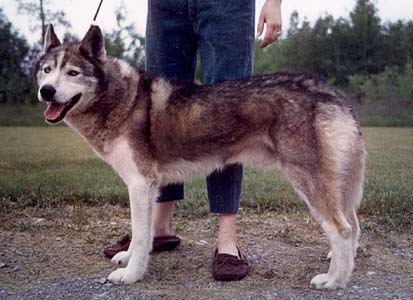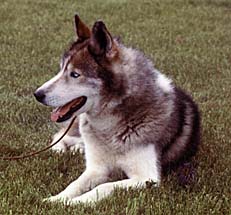 |
|
Copyright © 2003 J. Jeffrey Bragg |
 |
|
(Born 10 February 1959, by Toto of Seppala ex Zaza of Seppala) Photo courtesy Elsie Chadwick, Siberian Husky Archives |
 |
|
Copyright © 2003 J. Jeffrey Bragg |
 |
|
(Born 10 February 1959, by Toto of Seppala ex Zaza of Seppala) Photo courtesy Elsie Chadwick, Siberian Husky Archives |
Forty years ago . . .
WITHOUT
QUESTION the most crucial period for the pure Seppala Siberian
was the twelve years from the closing of the McFaul Seppala Kennels
until the dispersal of the young stock bred at Markovo Kennels. This
was the period when Seppala strain might well have been lost forever
in its pure form; it was, in fact, a very close brush with extinction
for Seppalas.
The major breeders of Seppalas, those
who carried on after Leonhard Seppala returned to Alaska in 1932,
were always at great pains to breed only the pure stock that went
back to the Poland Spring kennel, or to Sepp's breeding in Alaska, or
to his last Siberia imports in 1930. Other Siberians were still
around, including those from the Cooney, Johnson and Dufresne
bloodlines, all out of Alaska. More importantly, there was stock from
Eva B. Seeley's Chinook Kennels in Wonalancet, New Hampshire. But
Harry Wheeler, Alec and Charlie Belford, William L. Shearer III and
(after 1950) J. D. McFaul, all refused to make use of these sources.
Seppala strain over the years developed its own main trunk of
breeding lines that were entirely separate from the Seeley, Demidoff,
Lombard, Bowles and other New England kennels, and from the emerging
show-dog bloodlines that began to resemble the original Siberian dogs
less and less as the show ring made its influence felt. In truth,
Seppala strain had existed as a breed unto itself. But it was never
great in numbers; the major breeders kept it very expensive and
culled surplus females. Its existence depended upon a small cadre of
dedicated breeders.
BY 1970 THE
LAST surviving McFaul dogs were seven years old or more. J.
Malcolm McDougall had by then ceased to breed Siberians and was
running mostly Alaskans on his team. So was Charlie Belford and
anyone else who wanted to be seriously competitive in major dogsled
races. Over the years races had gotten shorter and faster. Trails
were much better groomed, lightweight nylon harness was in general
use and plastic runner surfaces were beginning to appear, replacing
steel shoes. The Siberian Husky had come into great disrepute in
serious sleddog racing circles for a variety of reasons.
For one thing, the volume of show and
pet breeding had totally swamped the racing bloodlines. Prior to
1950, little distinction between show and racing strains had really
existed; the same bloodlines and often the same dogs were both shown
and raced successfully, indeed, a number of Wheeler and McFaul dogs
were shown to their Championships. But by 1970 the distinction was
fully drawn and the show/pet stock was in the vast majority. The
show-dogs were bred to suit a new generation of non-specialist
all-breed judges, who knew that a dog had to be big,
heavy-set, large-boned and underangulated in order to pull a sled.
Racers who took their prized lead dog into the show ring were often
told, "your dog just doesn't look like it could pull a sled"!
Disgusted by the new situation, serious sleddog racers abandoned the
Siberian in droves, writing the breed off as a hopeless case.
The desertion of the Seppala Siberian
by people like McDougall, Belford, Lombard and Bryar, together with
widespread lack of interest in maintaining the breeding population of
the strain during the seven years following McFaul's retirement,
brought about the absolute nadir of the Seppala Siberian. Deserted on
all sides, abandoned and aging, Seppala dogs were a figure of
ridicule at the time. The show people called them "ugly -- dirty
faces -- mismarked" and the racers simply jeered "too slow". To
express an interest in Seppalas was to be laughed at from all
sides.
IN THE SUMMER of 1968 J. Jeffrey Bragg had been in Canada for exactly one year, and it had taken me no longer than that to acquire a pair of show-pet-stock Siberian Huskies and a novice's enthusiastic interest in the breed. My two pets were well on their way to their show-ring Championships, we had bred a couple of litters, I belonged to a breed club, subscribed to "Northern Dog News" -- and was puzzled by the obvious difference between the show Siberians and the dogs in old photographs of the All-Alaska Sweepstakes teams. John Johnson's KOLYMA, Leonhard Seppala's SCOTTY and TOGO -- they were so different from my dogs and the others I saw in the ring.
A
professional handler and old-timer Malamute breeder, Lorna
Jackson (who had had M'Loot strain Mals, not Seeleys), urged
me to visit Mrs. Bunty Goudreau in Chelmsford, ON. My wife
Mary and I drove up past North Bay to the Sudbury area and
found Snow Ridge Kennels on a back road. I first saw DITKO
OF SEPPALA tied in the bush beside Bunty Goudreau's log
cabin, a 48-pound, plush-coated, reddish-brown, blue-eyed
male. Several of his progeny were there, some of them
dark-faced, almost without white facial markings; they were
small, compact, well-angulated and totally unlike any
Siberians I had seen previously -- except perhaps for those
in the Alaska photos from the dawn of the breed! When I
mentioned the resemblance to Bunty, I was told that she had
been given DITKO by her mother Peg Nansen (formerly
Elizabeth M. Ricker) who "had wanted her to have at least
one Siberian like those that she and Seppala had in the
1920s"!

We returned
home with a little bitch, SNOW RIDGE KODA, who was a daughter of
DITKO out of Bunty's mixed-lineage breeding. KODA was unlike any of
our other Siberians, small, compact, with a large white blaze but no
eye-spots; she had dark ear-linings and her facial colour extended
down the sides of her muzzle. My wife called her "the little
sausage." KODA looked primitive beside our show dogs.
That autumn I returned to Snow Ridge
with KODA -- to breed her to her sire! At that stage I knew no
better. KODA duly delivered the Tadluk D-Litter, consisting of
TADLUK'S DAVIK and two sisters. I was disappointed that they were not
little replicas of their sire, but at that point I still had
everything to learn about Seppala strain.